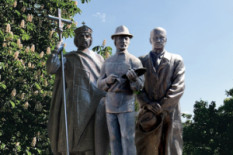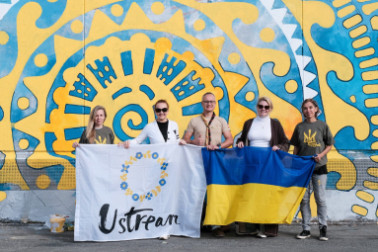This is the largest of Switzerland's three geographical zones. It shares the Alps with seven other countries: Germany, Austria, France, Italy, Liechtenstein, Monaco, and Slovenia. They have all signed the Alpine Convention to coordinate their policies and ensure sustainable development. Additionally, the protection of Alpine regions is enshrined in the country's constitution.
Mountains - Switzerland's Symbol
The Alps have always shaped the country's identity and hold important historical and geopolitical significance. While the primary economic activity is concentrated on the Swiss Plateau, the economy also relies heavily on the mountains. Numerous tourist routes traverse these peaks. Numerous mountain passes, and tunnels in the Alps play a significant role in transportation connections.
 Interesting Facts about the Alps
Interesting Facts about the Alps
- The Alps cover 60% of the country's territory, yet only 25% of the population lives in the mountains.
- Forests cover 23% of the central part of the Alps and around 50% in the southern part of the mountain range.
- Out of 82 Alpine peaks with altitudes above 4000 meters, 48 are located in Switzerland.
- More than 1200 peaks with heights between 2000 and 3000 meters are located in the canton of Graubünden.
- The canton of Uri holds the record for the highest density of peaks between 2000 and 3000 meters, with a mountain peak every 2.5 square kilometers.
- The highest funicular station is situated at 3820 meters on Klein Matterhorn.
- The highest peak, Dufourspitze, at 4634 meters, is part of the Monte Rosa massif. It was named in honor of General Guillaume-Henri Dufour, who created the first map of Switzerland.
- The highest railway station in Europe is located on the Jungfraujoch at an elevation of 3454 meters.
- Europe's highest mountain restaurant is situated at an elevation of 1600 meters in Montsteine in the canton of Graubünden.
- Europe's highest tram operates at 2222 meters in Zermatt, in the canton of Valais.
- The tallest external elevator in Europe reaches a height of 153 meters (Hammetshwand, Bürgenstock, Nidwalden).
- The Pilatus Railway operates the steepest cogwheel railway in the world (gradient - 48%) in the canton of Lucerne.
- Europe's steepest funicular (106% gradient) is located in Gelmer, near the Grimsel Pass in the canton of Bern.
- The steepest postal road in Europe (gradient - 28%) is in Kiental in the Bernese Oberland region.
- The Aletsch Glacier (Aletschgletscher) in Valais, measuring 23 kilometers, is the longest in the Alps.

A Guide to Switzerland's Most Famous Mountains
Bürgenstock
Bürgenstock is located on the shores of Lake Lucerne. This popular resort offers breathtaking views at an altitude of 874 meters above sea level. You can reach the top via Europe's highest outdoor elevator, Hammetschwand, or take the oldest funicular in Switzerland from Lucerne.
Eggishorn
Standing 2926 meters above sea level, Eggishorn provides a stunning view of the Aletsch Glacier, a vast icy expanse descending from the heights. There are over 1000 kilometers of mountain trails on the glacier.
 Fronalpstock
Fronalpstock
Fronalpstock is located on the shores of Lake Lucerne. With 1922 meters above sea level, it hosts a hotel restaurant with panoramic views. The summit offers vistas of the Rütli meadow, situated directly below the lake's opposite shore.
Jungfraujoch
Jungfraujoch is perhaps one of Switzerland's most famous mountain peaks in the Bernese Oberland region. You can ascend to Europe's highest railway station by train at 3454 meters above sea level. Along the way, you can visit the Ice Palace with its ice sculptures of eagles, penguins, and bears frozen in time.
Männlichen
In 1954, a cable car was built from Wengen to Männlichen, ascending tourists to 2222 meters above sea level. In 1978, it was replaced by the world's longest-hanging cable car, spanning 6 kilometers.
 Matterhorn
Matterhorn
The Matterhorn is Switzerland's most recognizable symbol. It is depicted on the packaging of Toblerone chocolate, borrowing its pyramidal shape from the mountain. The first successful ascent of the Matterhorn was achieved in 1865. It remains one of the world's most challenging mountains to conquer due to numerous fatalities during attempts. The mountain is located near Zermatt.
Mont Fort
With an altitude of 3328 meters above sea level, Mont Fort is the highest peak in the Four Valleys region in the canton of Valais, near Verbier. You can climb from either Haute-Nendaz or Verbier.
Monte Generoso
Mount Generoso is situated on the southern edge of Lake Lugano in the canton of Ticino. Its summit offers a splendid panoramic view of the surroundings. The mountain stands at 1704 meters, while the observation platform is slightly lower, at 1601 meters.
 Monte San Salvatore
Monte San Salvatore
Mount San Salvatore, 912 meters above sea level, is located in the canton of Ticino near Lugano. A cable car takes you to the summit in just 12 minutes from Paradiso in Lugano. A 15-minute walk further rewards you with a panoramic view of Lake Lugano and Lombardy.
Monte Tamaro
Mount Monte Tamaro rises in the canton of Ticino. The 1530-meter-high peak is accessible via a cable car. The mountain is famous for its chapel, designed by Mario Botta, a prominent representative of the Ticino architectural school. Pay attention to the sculpture of the Virgin Mary, which the Pope blessed.
Muottas Muragl
Muottas Muragl is renowned for its stunning views of Lake Engadin. The sunset there is awe-inspiring, leaving a lasting impression on those who experience it. The mountain stands at 2456 meters, and you can reach it in 10 minutes by funicular from Punt Muragl, near St. Moritz.
 Pilatus
Pilatus
Mount Pilatus stands at an elevation of 2132 meters above sea level. From its summit, a panoramic view of 360 degrees unfolds over Central Switzerland. According to legend, the mountain's name is linked to the name of Pontius Pilate.
Piz Nair
The height of Piz Nair reaches 3057 meters above sea level. It is located near St. Moritz. The summit is adorned with a sculpture of a majestic ibex standing on a pedestal, gazing down at the Upper Engadine valley below.
Pizol
The name Pizol translates to "high peak" in Romansh. Along the modern cable car route, you can ascend to the summit at 2227 meters above sea level, from Wangs to Pizol Hut. From here begins the incredible "5 Lakes" hiking route, each lake with its unique color, from blue-green to milky gray and even black. The mountain is located near Bad Ragaz in the canton of Graubünden, in eastern Switzerland.
 Rigi
Rigi
Mount Rigi is often referred to as the "Queen of the Mountains." In 1875, the first mountain cogwheel railway was built here, connecting the summit to the town of Vitznau. It elevates tourists to around 1800 meters above sea level, overcoming a vertical difference of 1313 meters. The summit offers a panoramic view of Central Switzerland, Lake Lucerne, Lake Zug, and Mount Pilatus. Moreover, it boasts one of the closest and best toboggan runs (near Zurich).
Rochers-de-Naye
Mount Rochers-de-Naye is a peak at 2045 meters above sea level. It offers a panoramic view of Lake Geneva and the surrounding Alps. Apart from the breathtaking landscapes, the mountain's prominent landmark is a park with marmots and the alpine garden "La Rambertia." The mountain can be reached by train from Montreux.
Säntis
Säntis is the highest mountain in Eastern Switzerland, with an elevation of 2502 meters above sea level. On the way to the summit, you'll be treated to stunning views of Lake Constance, the Prealps region, the cantons of Graubünden, and even the Bernese Alps on a clear day. The Black Forest in Germany can also be seen from here.
 Schynige Platte
Schynige Platte
The railway connecting Schynige Platte and Wilderswil (near Interlaken) was established in 1893. From the summit (1957 meters above sea level), you can enjoy spectacular views of the Bernese Alps and the triumvirate of peaks: Eiger, Mönch, and Jungfrau. An Alpine botanical garden is located near the station.
Sunnegga / Rothorn
To this mountain standing at 3103 meters above sea level, you can travel on modern mountain trains departing from Zermatt (in the Valais canton in southwestern Switzerland). You can admire the beauty of another renowned peak – the Matterhorn.
Titlis
The cable car ride to Mount Titlis near Engelberg is unique, featuring rotating cabins that allow you to comfortably and unhindered take in the mountain and glaciers. Titlis is the highest mountain in Central Switzerland, reaching an altitude of 3020 meters above sea level (Klein-Titlis mountain station). At the summit, a panoramic restaurant awaits with views of the Bernese Oberland and Lake Lucerne. In winter, you can go skiing and sledding here.
 Uetliberg
Uetliberg
Uetliberg is the most well-known mountain near Zurich, although its elevation is modest at 850 meters. Nevertheless, it offers a splendid panorama of the entire city, Lake Zurich, and the backdrop of the Alps on the horizon. Getting here is straightforward – take the S10 from Zurich's central station.
Weisshorn
Mount Weisshorn in the canton of Graubünden stands at 2653 meters above sea level. It is the highest mountain near Arosa. You can reach the panoramic platform on the summit from Arosa with just one transfer at 2013 meters.
Zugerberg
Zugerberg is a mountain located near the town of Zug. Its elevation is 925 meters above sea level. A modern funicular will take you to the summit in just 8 minutes. It's a popular spot for relaxation, walks, and non-alpine skiing trails. The "Schattenwäldli" playground and sculpture path are wonderful options for children.
This mountain guide from A to Z is a small contribution to your introduction to the Swiss Alps. Choose the ones closest to you and embark on adventurous journeys to these stunning alpine peaks.







